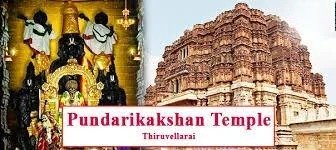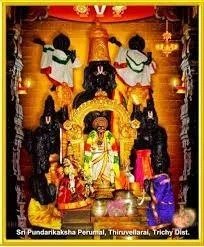Pundarikakshan Perumal Temple
The Pundarikakshan Perumal Temple or Thiruvellarai Temple in Thiruvellarai,a village in the outskirts of Tiruchirappalli in the South Indian state of Tamil Nadu, is dedicated to the Hindu god Vishnu. Constructed in the Dravidian style of architecture, the temple is glorified in the Naalayira Divya Prabandham, the early medieval Tamil canon of the Alvar saints from the 6th–9th centuries CE. It is one of the 108 Divya Desams dedicated to Vishnu, who is worshipped as Pundarikakshan and his consort Lakshmi as Pankajavalli.
According to legends, the temple is said to have been built by Sibi Chakravarthy, king of Ayodhya in Treta Yuga 15 lakh years ago. This temple is older than Srirangam temple. The temple has three inscriptions in its two rock-cut caves, two dating from the period of Nandivarman II (732–796 CE) and the other to that of Dantivarman (796–847). It also has Pallava sculptural depictions of Narasimha and Varaha, two of the ten avatars of Vishnu.
A granite wall surrounds the temple, enclosing all its shrines and six of its seven bodies of water. The rajagopuram, the temple’s gateway tower, is unfinished. A swastika shaped temple tank built in 800 CE by Kamban Araiyan during the reign of Dantivarman is outside the temple complex. The Vijayanagar and Nayak kings commissioned paintings on the walls of the shrine of Pudarikakshan, some of which are still present.
Pundarikakshan is believed to have appeared and showered his divine grace to Garuda (vahana of Vishnu), Sibi Chakravarthy, sage Markandeya and Hindu gods Bhoomadevi, Brahma, Shiva, Indra and Chandra. Six daily rituals and three yearly festivals are held at the temple, of which the chariot festival, celebrated during the Tamil month of Chaitra (March–April), is the most prominent. The festival is unique in the state as a community feast is offered, a custom stretching back many centuries. The temple is maintained and administered by the Hindu Religious and Endowment Board of the Government of Tamil Nadu.
History
Pundarikakshan Perumal temple is believed to have been built by the Pallavas, as seen from the three inscriptions in its two rock-cut caves. Two of the inscriptions are dated from the period of Nandivarman II (732–796 CE) and the other from the period of Dantivarman (796–847 CE). The temple construction completed presumably during the time of Dantivarman.The influence of Alvars, the Vaishanva saints of the 7th–9th centuries helped spread Vaishnavism to a greater extent among the public and the ruling Pallava kings, who became temple patrons.A Chola inscription indicates an endowment to the shrines of Krishna (an avatar of Vishnu) and his chief consort, Rukmini, inside the temple by King Parakesarivarman (907–955 CE).The temple had later additions from the subsequent Chola, later Pandyas, Hoysala and the Vijayanagara kings.The temple suffered extensive damage during a flood and was repaired by a merchant around 1262–63.
In modern times, the temple is maintained and administered by the Hindu Religious and Endowment Board of the Government of Tamil Nadu. An Executive officer appointed by the Board manages the temple along with Srirangam Ranganathaswamy temple, Sri Alagiya Manavala Perumal Temple at Woraiyur, Sri Vadivalagiya Nambi Perumal Temple and Mariamman Temple at Anbil. Annadhanam scheme, which provides free food to devotees, is implemented in the temple by the Board. Under the scheme, free food is offered to hundred devotees every day in the temple and the expenditure is fully funded by the contributions from devotees.


















